Pandemic Crushed Learning
Academic performance has fallen to the lowest level in decades.
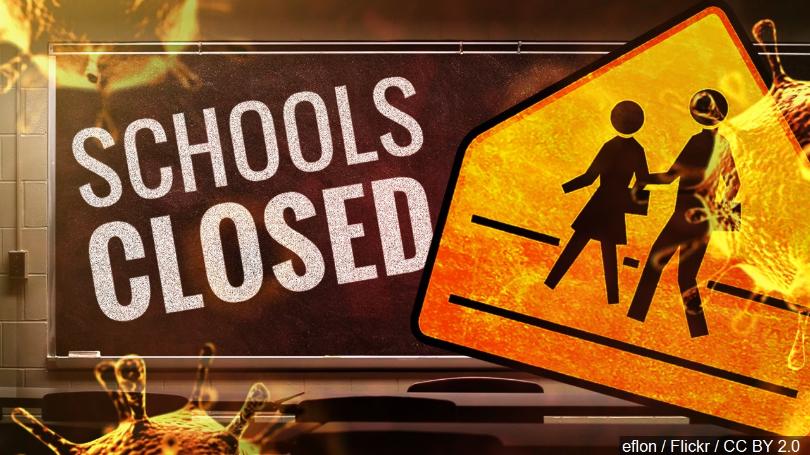
WaPo (“National test scores plunge during the pandemic“):
Test scores in elementary school math and reading plummeted to levels unseen for decades, according to the first nationally representative report comparing student achievement from just before the pandemic to performance two years later.
Math scores dropped seven points during that period, marking a first-ever decline, while reading scores slipped five points, producing the largest dip in 30 years on the National Assessment for Educational Progress, or NAEP, often called “the nation’s report card.” The students who took the tests — given from January to March in 2020 and in 2022 — were 9 years old and mostly in fourth grade.
“These results are sobering,” said Peggy G. Carr, commissioner of the National Center for Education Statistics, which administers the tests. “It’s clear that covid-19 shocked American education and stunted the academic growth of this age group.”
The falloff — which she called “historic” — left little doubt about the pandemic’s toll. The average math score of 234 this year was comparable to the average score recorded in 1999, and the reading score of 215 was similar to the 2004 score. How long it might take to catch up is unclear and not likely to be understood until further test results are analyzed.
Carr said the academic losses are part of a complex picture of pandemic schooling. Other studies have shown a rise in classroom disruption, school violence, absenteeism, cyberbullying, and teacher and staff vacancies, and schools also say more students are seeking mental health services. “There are a lot of factors that contextualize these data that we’re looking at,” she said.
NYT (“The Pandemic Erased Two Decades of Progress in Math and Reading“):
National test results released on Thursday showed in stark terms the pandemic’s devastating effects on American schoolchildren, with the performance of 9-year-olds in math and reading dropping to the levels from two decades ago.
This year, for the first time since the National Assessment of Educational Progress tests began tracking student achievement in the 1970s, 9-year-olds lost ground in math, and scores in reading fell by the largest margin in more than 30 years.
The declines spanned almost all races and income levels and were markedly worse for the lowest-performing students. While top performers in the 90th percentile showed a modest drop — three points in math — students in the bottom 10th percentile dropped by 12 points in math, four times the impact.
“I was taken aback by the scope and the magnitude of the decline,” said Peggy G. Carr, commissioner of the National Center for Education Statistics, the federal agency that administered the exam earlier this year. The tests were given to a national sample of 14,800 9-year-olds and were compared with the results of tests taken by the same age group in early 2020, just before the pandemic took hold in the United States.
High and low performers had been diverging even before the pandemic, but now, “the students at the bottom are dropping faster,” Dr. Carr said.
In math, Black students lost 13 points, compared with five points among white students, widening the gap between the two groups. Research has documented the profound effect school closures had on low-income students and on Black and Hispanic students, in part because their schools were more likely to continue remote learning for longer periods of time.
The declines in test scores mean that while many 9-year-olds can demonstrate partial understanding of what they are reading, fewer can infer a character’s feelings from what they have read. In math, students may know simple arithmetic facts, but fewer can add fractions with common denominators.
The setbacks could have powerful consequences for a generation of children who must move beyond basics in elementary school to thrive later on.
My girls were in 3rd and 5th grades when the pandemic hit and just started 6th and 8th grade. They’re in one of the top public school districts in the country, had access to school-provided laptops and broadband wifi at home during the long shutdown, and had two adults with doctorates (one, a former schoolteacher) providing support. There’s no doubt in my mind that they fell significantly behind with the half-assed instruction that was able to be provided.
That was especially true of my youngest, who is both dyslexic and hard of hearing, needing significant accommodations that were just getting put into place before the pandemic kicked off and which essentially went by the wayside during the shutdown.
That said, it’s not obvious what the alternative was. Conservatives on my Twitter feeds are trotting out I told you so‘s but it certainly wasn’t clear in the early days of the pandemic that young children were at much lower risk than even healthy adults. And, even if we had known that, it’s perfectly understandable that schoolteachers—a huge percentage of which are in high-risk groups—were reluctant to return to in-person school before vaccinations became available. (And many even then.)
Mostly, this strikes me as another tragic outcome from a larger tragedy. As of this morning, the virus has taken an estimated 6,496,708 lives. We probably shouldn’t be surprised that there were other negative fallouts.


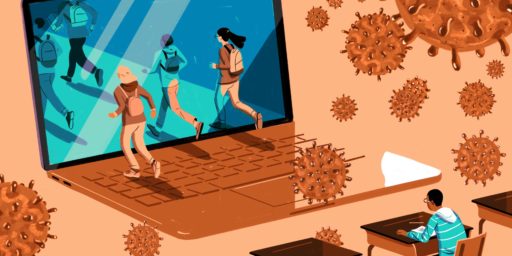
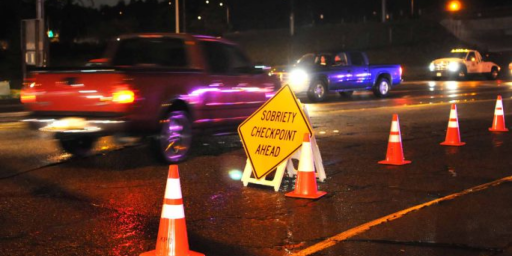
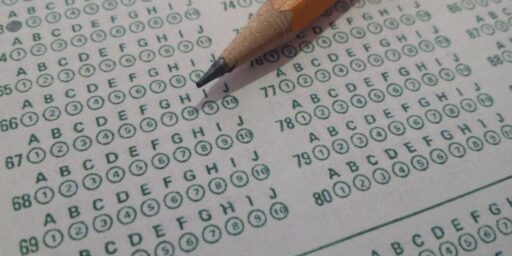
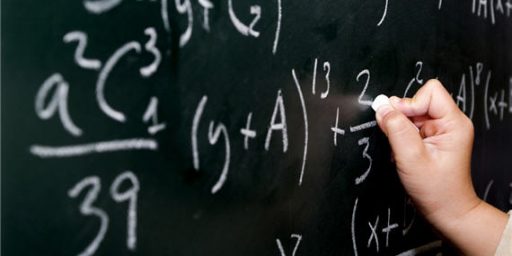
I think you intended the opposite?
Schooling suffers during any major societal crisis – I’m sure Ukrainian children are falling behind as well even if they made it safely out and are in school elsewhere. This is one of those things what as inevitable as soon as mass illness and death began. Our society was set up in a particular way and as soon as it was disrupted, it was to be expected that quality of life would suffer.
That being said, test scores do not necessarily reflect schooling, knowledge retention or capability. America teaches to the test, not tests whether kids really understand the material. I joked at the beginning with a friend score would either go down because you couldn’t cheat off the kid sitting next to you or go up because now you could google the answer without the teacher seeing.
I would also note that remote schooling also tends to assume parents/guardians can or will pick up some of the slack in teaching; since the teacher can’t sit with the child to work on something, you might need to. How many parents made time to try and fill in the gaps in their child’s education by sitting with them and reviewing the material daily? Very little, I suspect either from lack of time or ability to straight out DGAF. Is your kid have trouble with fractions? Did you sit with them to work on that or look up a youtube video to help explain the concept? Teachers are the front line soldiers in education but parents are the rear guard & cavalry – you need to step in if the battle’s not going well and take care blind spots that might ruin the day.
@MarkedMan: Right – but that quote, when corrected, is at the very essence of why conservatives can’t be saying “I told you so.” They didn’t know any more or less than anybody else. Teachers did actually die from some schools opening up quickly. How much you weigh that against severe learning setbacks (affecting disadvantaged students the most) is a dilemma. Reasonable people can disagree, but at least I have faith that most of my fellow liberals gave it some true consideration, as opposed to the conservatives’ knee-jerk response to screw teachers in any way they can.
Indeed. The reality is that even if children were immune (which is clearly not the case) it is awfully hard to keep the teaching infrastructure going if the adults are constantly getting sick.
It was just a terrible situation, made worse by poor public health decisions from the very beginning when the President was dismissing it and promising that it would go away any day.
And as noted, 6+ million dead worldwide and 1+ million in the US is indicative of a massively disruptive event.
It’s one test given to a bunch of kids. I find it very hard to believe that there were no negative effects of virtual learning. But calling the impact ‘profound’ or saying it set back twenty years of progress…give me a break. How can you even isolate as a cause access to education when 1 million people died? Around 100K children lost a caregiver, I think, and I’m sure that the material impact of that was worse the poorer you are.
Also consider the source. If the education establishment said that the same kids needed mandatory lessons in diversity conservatives would be freaking out and calling for execution. But since we’re talking about a pandemic where one million Americans died the notion of any kind of shared sacrifice is enough to make the same people go ballistic.
@Steven L. Taylor:
Indeed. I’m sure there’s under-reporting in many countries (but then there’s also under-reporting in many U. S. counties). But we have 4% of the world’s population and 15% of reported deaths. Way To Go Trumpsky!
IIRC the early Imperial College model said the U. S. would lose 2 million dead if we did nothing. That was regarded as a huge pending catastrophe. We didn’t do nothing, but we didn’t do much, and we lost 1 million (so far). Looks like the model was pretty good. But we’ve come to regard a million dead as just c’est la vie.
There seems to be a general feeling that the government (but not Trump) put us through all that (I couldn’t go to my favorite sports bar, the greeter at Walmart asked me to wear a mask, and I had the kid home all day asking for help with his math) and we still have COVID anyway. People didn’t get that the idea wasn’t to eliminate COVID, but to “flatten the curve”, to reduce deaths by not overwhelming the hospitals. A goal we met, just barely, and with local exceptions. Do people still remember the freezer trucks?
@Modulo Myself:
Sean Illing had a good interview at VOX with one Stuart Jeffries, author of Everything, All the Time, Everywhere: How We Became Postmodern. He ties postmodernism and neoliberalism to the loss of a sense of community. Illing said,
If the “news” at FOX makes me feel better than the news in NYT, why shouldn’t I just accept FOX’s reality as my personal reality?
@MarkedMan: Yes–fixed.
@KM: Parents are of very mixed ability and capacity to do that. We did a lot, obviously, but there’s only so much bandwidth.
@Franklin: There were plenty of early indications from Europe that kids were impacted much less than adults but, again, I understand why we erred on the side of caution. I think we continued doing that far too long given the evidence but, again, teachers had a vote, too.
Well, kids are broken to the classroom by 3rd grade and then you took that away from them. And we see almost all schools induce “school helplessness” in their students making them dependent up on teacher. This latter is not a bad deal for “educators” since even adults feel they must find a teacher to learn school-like subjects creating the “training” industry. But taking initiative in learning from children means if you abandon them as happened when schools closed, they don’t have the habits necessary to learn in the new environment. It should be noted that early on, there were the stories of kids whose parents had learned just how miserable their kid had been in school and how much they learned when given their head and access to material.
However, the incentive of school is to get good grades. (See Paul Graham’s ‘The Lesson to Unlearn’, Dec 2019) Real learning can interfere with that. So most students learn to game the system to survive. Learn what is needed to get the grade, then move on to the next topic. Learning to deeply about a subject and you might not parrot the right answer to the teacher.
The decline in “getting good grades” is unfortunate, but we don’t know yet how many kids aren’t learning and how many have recovered to become real learners once freed from the traces of the classroom. Granted, colleges reward those who are conditioned to get good grades, sometimes penalizing those who do real learning. Consider this anecdote by Joseph Epstein regarding how his cousin was almost washed out of grad school for not being good at gameshow answer “education”. Spoiler: individual was chairman of an economics department at his death.
@gVOR08:
What was weird was the lack of solidarity from the very beginning. Within days, the Republicans were frothing at the entire idea of Covid being real and requiring sacrifice. Not after months or a year of dealing with Covid, but days. I don’t think you can chalk that up to individuality or postmodernism. Hatred of others is not a mark of individualism. It might be consumerism, but of a specific type.
@JKB: That’s a tangent, but it’s food for thought and there are definitely some people here that would agree to some extent (iirc, de stijl is not a big fan of traditional schooling).
You have pointed out that different kids learn differently. Yup, and most teachers know that and would like to spend more time working individually with each student. Unfortunately, we choose to defund and punish schools that don’t teach to the test in an assembly line fashion. Better student-teacher ratios would be far more effective.
@gVOR08:
I’ve seen this claim pop up a few times lately, and it’s just wrong.
The pre-vaccine goal was to flatten the curve.
The early vaccine era goal was to get to herd immunity, and wipe out covid in the US.
Unfortunately the virus proved to be be able to reinfect, and to bypass our vaccines (vaccines still great at preventing death!)
The current goal is to … I don’t know, actually. Vaccinate the people who are willing to be vaccinated and let ‘er rip?
The goal changed. And the current goal is nebulous at best — when elimination turned out not to be possible, the national discussion was not “how do we balance risk and reward living with this?” it was the right wing screaming “I told you so!” and the centrists just giving up.
@gVOR08:
One death is a tragedy. A million deaths are a statistic.
Stalin was attributed the above.
@James Joyner:
Children don’t exist in a vacuum. They bring diseases home to their families.
During the flatten-the-curve period and the eliminate-covid period it made more sense to keep kids home to cut down the transmission.
Part of what upsets me now is that we entered the live-with-it (or, y’know die from it) period without bothering to set up any guidelines to reduce that transmission vector. Nothing about recommended ventilation standards for workplaces, and no significant efforts to make that happen.
We should have a recommendation based on CO2 (a decent proxy for outside air coming in is low CO2), HEPA filtration (and number of air rotations per hour) and quality masks when air quality cannot be reached (and since people hate masks, that serves as a good incentive to improve the air quality)
I think the teachers and staff gave in too quickly. They’re in an unsafe working environment, and a victory for workers there would have spread to workers in other industries.
@Kathy: I do love quoting Stalin, even when it is clear that he never said it or wasn’t the first.
He’s a more fun source than Benjamin Franklin, Abraham Lincoln or Mark Twain.
@Gustopher:
There may not have been public announcements about it, but the information was being disseminated. Our factories were in contact with someone about ventilation standards, because our facilities teams worked on changing airflow in our system to meet the criteria they were given. The Executive team didn’t share the specifics with us, but they did send a company-wide e-mail saying this was being done according to standards set by some form of experts.
I’ll say this: Our Executive team (CEO, COO, and VPs) were extremely transparent about what was being done, and why it was being done. And during the lock-down & furloughs, they did everything they could to make sure that everyone was okay and nobody took a serious financial hit. So… 50% furlough was every other week, so the off-weeks people could qualify for full unemployment. They paid 100% of our insurance (we’re self-insured, and pay $100/mo for top-tier insurance) for an entire year. And they reminded everyone that there’s a “vacation pool” where people can donate unused vacation days for people who need it (that’s been going on for years).
@James Joyner:
Hindsight should not count in judging the past.
But it is a very valuable tool for the future. One we’ve not made use of, seeing as each wave of trump disease kind of reflects the previous ones.
We need to do a deep study of the pandemic. How ti spread, what containment measures worked, what measures didn’t work, etc. All to determine how best to proceed next time. I’ve said this a number of times.
I suspect we’ll find that the most effective tools to contain the spread are:
Testing coupled with contact tracing and isolation.
Masks.
Capacity limits in public venues and private gatherings.
Social distancing.
Overall hygiene.
Vaccines.
You’ll notice I don’t list lockdown. While it does work (see the trends during lockdown in the early stages of the pandemic), it imposes large social costs, not the least of which is turning people against public health measures. It should be reserved as a temporary measure only when things get really bad.
@Franklin:
Better student-teacher ratios cost money. Some districts attempt to tinker at the edges with s/t ratio by hiring paraprofessionals (ETA: who earn slightly less than what a substitute makes–about half of what a teacher makes) to provide additional assistance to struggling students (one of the schools at which I substitute has about 2o or so, not including one’s imbedded in SpEd classes). Even more to the point, though, is the problem of attracting enough teachers of enough personality types/approaches to match to the differing learning styles. For the students for whom the climate of the classroom is off-putting, having 15 available distasteful classroom experiences is no better than having eight.
@Mu Yixiao: Without disseminating information about what is being done, and what the levels of compliance are, I have to assume the answers are “not much being done” and “not much compliance”.
The engineer in me wants clear goals, and graphs towards compliance, and ideally the something like little posters some cities have restaurants show with their health inspection scores.
I would love to discover that every workplace, large or small, has been secretly retrofitted to provide clean, safe air, and that this is being monitored. I doubt that.
Good on your employers for doing something.
My feelings on programs like this are incredibly mixed. Feels like something that should just be covered by bereavement policies, short-term disability and more flexible sick leave policies.
@Kathy: One death among people I know is a tragedy. Deaths among strangers? Meh… not so much without a tragic backstory.
@Gustopher:
A couple responses to that:
1) Vacation time is a fiscal liability on the company–millions of dollars for our company of ~1200 employees. When it’s in the pool, it’s not. We get 14 days of PTO per year (on anniversary date, does not roll over), and 10 days of earned vacation, adding a day every year. 160 hours can roll over. There are people who have been here for 40 years. That’s 12 weeks of vacation. Those who donate their vacation get 1/2 pay for it–which is great for those who have way more vacation than they’re going to use.
2) Our company has all the things you mention, but the vacation pool is not just time, it’s money. So days in the pool can be converted to money and used to purchase items for families who’ve had a tragedy occur, such as a fire, flooding, even major theft. During the lockdowns it was made available for people who needed a little extra to make rent payments and such.
I guess I’m lucky that I lived in a public school district where at least part-time in person class returned in the fall of 2020, and parents had the option of all-online as well.
Even then, we had to move our son to a different school in the district that was full-time four days a week, and my daughter – now in college – is still in therapy from some of the issues that were partly related to Covid.
People can judge the efficacy of a wide range of approaches that different districts and schools took based on the outcomes, which will hopefully better inform decision-makers the next time something like this happens.
If we were to need to close schools again, for Next Pandemic or whatever, I would hope that we learn something from these experiences.
In-person schooling cannot be cut without helping parents cover some of that time they need to help their kids learn.
@James Joyner:
If the PPP “loans” were available to pay full wages while cutting parents hours, for instance, James’ kids might be a little better off. Maybe one day a week off. And other people’s kids (people who don’t start with the advantages James does) would have been much better off.
And resources to help parents learn how to help their kids learn, which seems to have been lacking.
We threw this all together quickly and haphazardly, and honestly we’re lucky the little monsters didn’t just go feral.
@Mu Yixiao: Your employer seems to be implementing vacation-banks better than most, where it is often a substitute for decent policies rather than an augmentation of decent policies.
Maybe I’m jaded, maybe it’s the industry I am in, maybe there’s something else going on, but typically when benefits are defined in a nebulous manner, and workers are encouraged to contribute to each other… typically it is just a way of screwing over workers.
I would put everything from an Ohio Wal-Mart having food collection for their employees thanksgiving to tech startups offering unlimited vacation in the same bucket — screwing over workers. Also tipping.